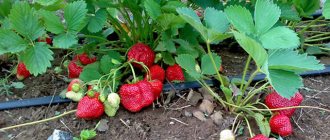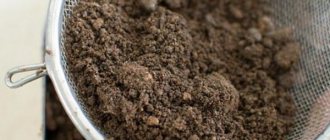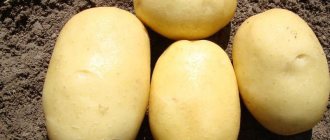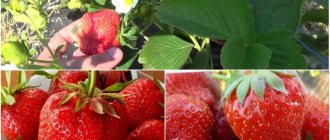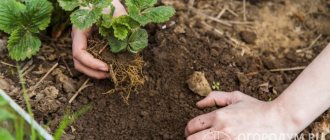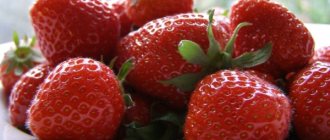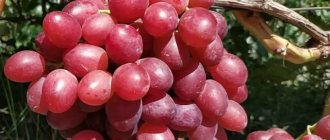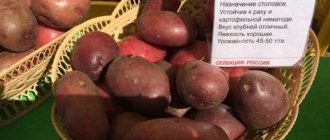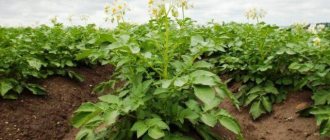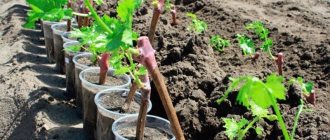Large-fruited Asia strawberries “came” to us from Europe, where in 2005 a patent was issued for a new Italian variety of garden strawberries. Since 2015, seedlings of the variety have been unofficially tested by our summer residents. The Asia variety is still not listed in the State Register of the Russian Federation, but this does not in any way affect its popularity, which is growing every season.
Description of the variety
Strawberries of the Asia variety are distinguished by a powerful root system, which is important for adaptation to our climate. The Italian “sissy” is able to withstand the winter frosts of the Middle Zone, and under a snow cover of 25...30 cm, it winters well in the Urals and Siberia.
Our friends have launched a resource about the secrets of growing grapes in Central Russia. We bring to your attention the article: The most spectacular new product of recent years - sultana Avatar
Bushes
Asian bushes match the roots - large in size, semi-spreading or erect with slightly wrinkled large leaf plates of rich green color. Few tendrils are formed from the central rosette, but there are many peduncles. So much that during one month of fruiting the bush can produce up to 1.5 kg. selected berries.
Asia is highly adaptable. It feels great and bears fruit: in open ground, under light film cover and in greenhouses, on a soil substrate and with the support of hydroponic installations.
Berries
The berries of the Asia strawberry are one-dimensional, 25...40 g, and do not become smaller during fruiting. When grown in greenhouses, there are giant specimens weighing 100 g and up to 7 cm in length. The shape of the fruit resembles a flattened cone with a truncated top, sometimes forked.
Berries with a glossy shiny surface are painted in a bright red (rich tone). When cut, you can see flesh of the same color without voids, only a slightly more delicate shade. The taste qualities of the fruit on a 5-point scale earned the tasters a rating of 4.8 points.
The berries have a dense consistency with a bright strawberry aroma and are suitable for fresh consumption, preparation of all kinds of winter preparations and deep freezing - they are a variety of universal purposes.
Productivity
Fruiting in open ground begins in the 1st decade of June (Central region); in the southern regions, the appearance of the first berries may shift to the 3rd decade of May. The variety is considered mid-early and is characterized by extended fruiting - the berries can be harvested in several passes over the course of about a month. From 1 linear meter of row (or 1 m2) you can get up to 6 kg per season. selected berries (1.0-1.5 kg per bush).
Pests and their control
The Asia variety is most often affected by mites - strawberry and spider mites. Strawberry nematodes and weevils can also damage the crop.
Common pests of the Asia variety and their control:
| Pests | Damage caused | How to fight? |
| Strawberry nematode | Small worms, up to 1 mm long, parasitize the plant, leading to metabolic disorders and the almost complete disappearance of berries. The leaves become deformed, the flowers become dirty green, the fruits become small and ugly. | Before landing, take a contrast shower (48 °C for 10 minutes, cold for 15 minutes). |
| Weevil | The larvae eat away the flower stalks. | Treatment at the budding stage with Inta-Vir. |
| Strawberry mite | The juices are sucked out of the leaves - they become wrinkled and oily. | Treatment with colloidal sulfur or Karbofos - early in spring. 2 weeks before flowering - Neoron. |
The main preventive measure to prevent strawberries from being damaged by pests is maintaining crop rotation. All diseased bushes must be dug up and destroyed.
a brief description of
Advantages of the variety
- early fruiting;
- high yield up to 1.5 kg. from a bush;
- excellent taste and aroma of berries;
- versatility - fresh consumption and processing;
- the berries are easily removed from the stalks;
- harvested fruits tolerate transportation well;
- beautiful presentation;
- storage for up to 5-7 days in cool conditions without loss of commercial quality;
- the berries do not become smaller during the season and as the bush ages;
- increased resistance to powdery mildew and chlorosis.
Asia strawberries ripen literally 4-5 days later than the Alba variety.
Disadvantages of the variety
- very mediocre resistance to drought;
- susceptibility to anthracnose and certain types of rot (primarily gray rot).
Resistance to diseases and adverse factors
Bushes without shelter in the middle zone freeze out. Strawberries can survive the winter well only if a thick layer of snow falls early and there are no thaws followed by frosts. In the southern regions, the Asia variety overwinters without problems and is damaged only at extremely low temperatures.
It is affected by pests in the same way as other strawberries. Preventive treatments, removal of plant residues from the beds, and soil improvement are needed. Garden strawberries can grow in one place for no more than 5 years, but in order to maintain high productivity, plantings are renewed every 2-3 years.
Strawberry Asia has shown good resistance to diseases of the root system, but is often affected by:
- powdery mildew;
- chlorosis;
- anthracnose.
Insecticides are used to control pests. If a mite appears on the bushes of the Asia variety, the preparations should have an acaricidal effect. Appropriate fungicides will help control diseases.
Landing
For planting strawberries of the Asia variety, both spring planting in April-May and autumn planting in August-September are suitable. Each option has its own advantages and disadvantages:
| Landing | Advantages | Flaws | Peculiarities |
| Spring | Seedlings take root more easily and grow quickly | You can’t count on a harvest in the year of planting | To obtain powerful plants and lay flower buds for next year, it is necessary to remove all peduncles and tendrils. |
| Autumn | Quite a decent 1st harvest next summer after planting | Bushes planted in autumn do not always have time to take root sufficiently and freeze out | During the first winter, the strawberry bed must be covered with agrofibre, spruce branches, leaves; in winter, additional snow should be added |
To grow Asia strawberries outdoors, you need to choose a site with suitable conditions:
- Level bed with good lighting.
- Fertile soil with a loose, breathable structure.
- Groundwater should not reach the surface at a distance of 1 m or less.
Attention! Damp lowlands and wetlands are unsuitable for planting strawberries. The bushes will constantly suffer from fungal diseases, and the roots will rot and “suffocate” from lack of oxygen.
2-3 weeks before autumn planting (for spring - better in the fall), you need to prepare the bed - dig up, select the roots of perennial weeds, apply fertilizer per 1 m2:
- 2 buckets of compost or humus;
- 1/2 bucket of sand or rotted(!) sawdust;
- 1/4 cup urea;
- 0.5 l. ash.
Spread the fertilizer evenly over the area and dig it up into 1 spade.
When planting strawberries, it is best to divide the bed for cultivation in paired rows (a variant of the strip method):
- The rows are placed in the north-south direction, which allows maximum use of sunlight.
- In the tape, the rows are placed at a distance of 45...50 cm from each other, the row spacing is left about 80 cm wide.
- Strawberry bushes of the Asia variety are planted in a row at intervals of 40...50 cm.
Attention! Planting of seedlings is carried out without deepening - the central rosette of leaves should protrude slightly above the soil level without exposing the roots. Plants planted “too deep” refuse to bear fruit, “high” - they bear little fruit, due to impaired root nutrition they get sick and may freeze out in the first winter.
After planting, strawberry seedlings should be well watered and mulched with a layer of loose organic matter at least 5 cm thick. This will help the plants survive the winter when planting in the fall or take root faster when planting in the spring.
Aftercare for raspberries
Immediately after planting, the Polki seedling is trimmed, leaving a few buds above ground level. Regular watering is required, but making the area waterlogged is more dangerous than drying it out a little.
Polka will have to be fertilized generously. The first feeding is needed in April. Nitrogen compounds are added to complex potassium-phosphorus compositions for active shoot growth. The second time Polka is fertilized between fruiting periods, approximately in July. The third feeding occurs in September. After harvesting the berries, organic compounds (rotted manure, compost) are laid out around the bushes.
A bountiful harvest can bend even the strong stems of Polka. Temporary T-bars or permanent structures will be required for support.
After picking the last berries and the onset of cold weather, it is recommended to cut the Polk raspberry stems flush with the ground and mulch them. Only shoots intended for the early wave of fruiting are left to overwinter. In spring they are also shortened to living tissue.
Growing and care
Correctly carried out planting with high-quality mulching of the bed significantly reduces the time spent on caring for strawberries - there is practically no need for weeding, watering, and loosening. A layer of organic mulch partially replaces fertilizing.
In early spring, even before flowering, comprehensive treatment of the beds against diseases should be carried out. Traditional Bordeaux mixture, which is used for spring treatment of the garden, works well against rot and powdery mildew.
In the absence of precipitation, watering strawberries is especially necessary in 3 periods:
- before flowering;
- during the period of formation of ovaries and ripening of the crop (2 times a week, 3 liters of water per bush);
- after harvesting (combine with fertilizing).
It is preferable to organize drip watering, otherwise loosening will have to be done after each watering.
The high yield of Asia strawberries is accompanied by the removal of nutrients from the soil - they must be replenished at the beginning of growth (April) and before flowering (early May).
Nitrogen fertilizers for spring feeding of strawberries, per 1 m2
| Organic | A solution of mullein (1:10) or chicken manure (1:15) diluted with water |
| Mineral | 50 g of urea per 1 bucket of water + 2 tbsp. spoons of ash |
After harvesting, the strawberry bushes begin to “throw out” tendrils, on which rosettes of daughter plants are formed. If you do not plan to expand your garden strawberry plantation, the tendrils should be removed immediately after emergence so that the mother plant does not lose vigor.
After harvesting, they begin to prepare the strawberry bed for winter: they feed it with complex mineral fertilizers such as Master or Agricola for berries, normalize the number of tendrils, and maintain optimal soil moisture.
In the conditions of the Central region, Asia strawberries overwinter well without shelter. In Siberia and in the foothills of the Urals, gardeners need to take care of protecting the beds with spunbond, spruce branches or dry leaves.
Important! Renew the layer of mulch for the winter - loose organic matter will protect strawberry roots from frost and replenish the lack of nutrients in the soil.
How to care for Asia strawberries
The agricultural technology for growing Asia is simple and not much different from caring for any other strawberry:
- The first thing to do in the spring is to remove the remnants of last year's mulch, dry leaves and dead shoots from the strawberries. Fallen leaves are carefully selected by hand or with a special rake so as not to damage the bushes, and those remaining on the plants are cut off.
At the beginning of spring, be sure to remove the remnants of last year's mulch from the strawberries and trim off dead shoots
- The Asia variety requires abundant watering. If there is not enough water, the bushes will develop poorly and form small, hollow berries. Water the strawberries as the soil dries out; for watering, use water slightly warmed in the sun. To prevent plants from getting burned, water them early in the morning or in the evening after the sun has set. Before flowering, strawberries are watered by sprinkling, and during and after it, water should be avoided on the leaves. Ideally, it is worth constructing drip irrigation for strawberries. In very hot weather, you need to water strawberries more often, but in no case do not water too often with small amounts of water - such tactics can provoke the development of diseases (primarily powdery mildew).
- In order for strawberries to grow well and delight you with a large number of large berries, they should be fertilized regularly. In early spring, nitrogen fertilizers are applied - a tablespoon of urea is diluted with a bucket of water and half a liter of solution is poured under each bush. But don’t overdo it—excess nitrogen can cause the berries to become crushed and lose their sweetness. During the same period, you can feed the plants with a small amount of potassium-phosphorus fertilizers - ash, superphosphate, potassium nitrate, etc. Complex mineral fertilizers for strawberries have an excellent effect - they are used in accordance with the manufacturer’s instructions. During the flowering and fruiting period, the plants are not fed.
- Be sure to weed out weeds, especially at the stage of berry formation - strawberries cannot tolerate them. A good option is to use black agrofibre for planting plants. This approach will prevent not only the appearance of weeds, but also excessive evaporation of moisture. Black spunbond is used to cover the soil during planting, holes are cut in it for the strawberry bushes, and left on the site until autumn.
You can plant strawberries under black agrofibre - this will prevent the appearance of weeds and drying out of the soil
- Periodically loosen the soil shallowly and mulch the rows (preferably with spruce needles). To protect plants from pests and diseases, carry out preventive treatments. In the spring, spray strawberries with copper-containing fungicides - Bordeaux mixture (0.1%) or Hom, Horus, Abiga-Pik. An effective method of pest prevention is spring spraying with colloidal sulfur or karbofos. A couple of weeks before flowering, strawberries are treated with Neoron. To strengthen the immunity of plants, after flowering they are sprayed with Zircon.
- At the beginning of autumn, strawberries are fed with fermented mullein, adding half a glass of wood ash to each bucket. Somewhere in mid-September, 20–30 grams of potassium fertilizers, 2 tbsp. are dissolved in a bucket of water. l nitrophoska and a glass of wood ash, and pour 0.5 l of solution under each bush. Such care will have a beneficial effect on next year's harvest.
- Since the Asia variety is not frost-resistant, strawberries need to be provided with good shelter for the winter. However, keep in mind that you need to cover the plantings no earlier than the temperature outside is below freezing (that is, it will stay there not only at night, but also during the day) - otherwise the strawberries may dry out. The most common method is to cover the plants with straw, but this is dangerous because the plantings can be damaged by rodents. You can cover the strawberries with spruce branches or spunbond, or it is best to build mini-tunnels. In the fall, plastic or iron arcs are installed over the beds, and with the onset of frost, agrofibre with a density of at least 50 g per square meter is pulled over them. In this case, an ideal microclimate for plants will be formed under the shelter, and you will not have to worry about the bushes dampening off or freezing. Before covering the strawberries, be sure to remove the weeds, remove dry leaves and remnants of the berries, and trim off any tendrils.
Strawberry pest table
| Pest | Description | Fighting methods |
| Nematode (chrysanthemum, strawberry or stem) | It disrupts metabolism and leads to an almost complete absence of berries. When this pest appears, the foliage becomes curled and deformed, and the cuttings become fragile. | When planting, carefully inspect the seedlings by soaking them first for 10 minutes in hot water, and then for 15 minutes in cold water. Never make new plantings where nematode-infested strawberries previously grew. For the garden bed to become suitable for growing berries again, at least 7 years must pass. All affected plants must be removed and destroyed. |
| Strawberry mite | It lays eggs on leaves, multiplies very quickly and can lead to large amounts of damage to plantings in just one season. Signs of damage include an oily coating and wrinkled leaves, and the berries practically do not increase in size. | Treating the bushes in early spring with colloidal sulfur or karbofos, and a couple of weeks before flowering with Neoron, helps to cope with it. |
| Spider mite | It appears in the second half of summer, sucking nutritious juices from the plant. This process leads to the death of plant cell tissue. | This pest can be easily controlled if, before flowering, you spray the plants with a solution of karbofos and tightly cover the treated plantings for 3 hours with plastic film. |
| Aphid | It affects foliage, multiplying on the underside of the leaf, causing it to curl and wrinkle. | To combat this unpleasant insect, you can use a folk remedy. Peel a few heads of garlic, cover with cold water and leave for a week. Treat the affected bushes with the resulting solution. |
| Strawberry sawfly | It chews out real patterns on the leaves, significantly damaging the plate and promoting infection by bacteria and fungi. | Periodically loosen the soil under the bushes and treat the plants with a solution of chlorophos (0.2%) or karbofos. |
| Weevils (gray earthy, root or strawberry-raspberry) | They gnaw leaves, stems and even buds; in large quantities they can cause the death of bushes. | Periodically loosen the soil under the bushes and treat the plants with a solution of chlorophos (0.2%) or karbofos. |
Useful video about caring for strawberries
Reproduction
Asia strawberries, like all varieties of large-fruited garden strawberries, can be propagated in several ways:
- dividing the old bush (as a last resort, with a small number of mustaches),
- layering rosettes,
- planting seeds.
The last, seed method, is usually used for breeding work. Vegetative propagation by air layering allows you to obtain a full-fledged fruit-bearing bush within a year without significant investment of time and effort.
Preparing for winter
When preparing plants for winter, you should first carry out moisture-charging watering, adding at least 5-8 liters of water to each bush. Then, a layer of humus or compost 10-13 cm thick is applied under the bushes as fertilizer and at the same time insulating the roots.
Strawberries of this variety have very strong roots, so this Italian variety tolerates cold Russian winters well. Without shelter for the winter, this plant can withstand cold temperatures down to -16-18 degrees Celsius.
, if the winter is snowy enough, then strawberries can survive severe Siberian frosts. But if there is no hope for heavy snowfalls during the winter, then before the onset of frost it is better to cover the strawberry plantation.
You can use spruce branches, straw or fallen leaves as covering material. Also, many gardeners recommend using non-woven material that allows air to pass through for covering.
Reviews
Asia is a good variety - tasty, large-fruited, productive, but in Crimea we have chlorositis. I tried to treat with orthophosphoric during drip irrigation and sprayed with iron chelate, but it didn’t help.
I planted three varieties of garden strawberries - Adria, Syria and Asia. The first grade is grass, but I really liked the second and third. The bushes are powerful, the berries are sweet.
Strawberry Asia is an excellent variety that is gaining more and more fans throughout Russia. Gardeners are primarily attracted by the large fruit and taste of the berries. Asia, Syria, Alba, Jolie are rightfully considered the best strawberry varieties of recent years.
Advantages and disadvantages
The benefits of garden strawberries in Asia include:
- mid-early ripening;
- productivity;
- no problems with pollination;
- extended fruiting;
- beautiful berries;
- universal use;
- keeping quality;
- resistance to many diseases;
- transportability;
- good taste;
- Asia produces few mustaches;
- there are no voids inside the berries;
- large-fruited.
The variety also has disadvantages:
- insufficient frost resistance of the Asia variety;
- high demands on fertilizing;
- for mass propagation you need to divide the bushes;
- sensitivity to anthracnose, powdery mildew.
